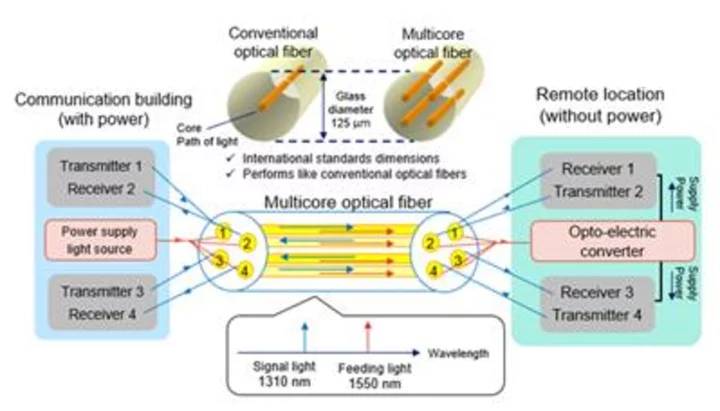TOKYO--(BUSINESS WIRE)--Sep 12, 2023--
NTT Corporation (NTT) and Kitami Institute of Technology, part of the National University Corporation Hokkaido Higher Education and Research System (KIT), have achieved a groundbreaking milestone related to the delivery of power for high-speed communications. The collaboration has successfully delivered electric power exceeding 1W to a remote location over more than 10 km using a single optical fiber. This achievement marks the world's first instance of maintaining high-speed and high-quality communication while transmitting power through an optical fiber.
This press release features multimedia. View the full release here: https://www.businesswire.com/news/home/20230912720066/en/
Figure 1: Overview of Optical Feeding System Using Multi-Core Optical Fiber (Graphic: Business Wire)
This technological breakthrough paves the way for extending high-speed optical communication to underserved regions, including areas without electrical power, and establishing emergency communication methods through optical fiber in disaster-stricken situations. Details of this pioneering research will be presented on Oct. 4, 2023, at the 49th European Conference on Optical Communications (ECOC), the world's largest international conference on optical communication technology, taking place in Scotland.
In today's world, optical communication technology and wireless access are essential for high-speed data communication. However, providing power to remote areas to establish base stations for radio access and optical communication transmitters and receivers remains a challenge. Additionally, natural disasters such as earthquakes, floods, fires, hurricanes and typhoons, may result in prolonged power outages, underscoring the need for rapid communication in affected regions.
To address this issue, researchers have been investigating the transmission of two types of optical signals—one for communication and another for power supply—through a single optical fiber. Traditional technology limited the distance over which power could be supplied to drive optical communication devices to under 10 km due to optical fiber input light intensity constraints 1. NTT has been at the forefront of research and development in multi-core optical fiber (MCF) 2, a key technology for enabling high-capacity optical transmission within the framework of IOWN (Innovative Optical and Wireless Network) 3.
This study utilized MCF, which consists of four optical paths (cores) with the same diameter as the commonly used optical fiber for communication, to achieve the world's highest self-powered transmission capability. The optical power transmission system using MCF is depicted in Figure 1. The MCF employed in this research matches the thinness of existing optical fibers, with each core exhibiting transmission characteristics identical to those of standard optical fibers. As such, it can be seamlessly integrated with existing transmission equipment for conventional optical communication (i.e., optical communication not requiring optical power supply). Each core can function independently, avoiding optical signal interference between cores, allowing for core allocation to power supply, communication or both.
In this study, to maximize optical power supply, a 1550 nm wavelength light source was introduced into four cores. Additionally, two of the four cores were allocated both up and down signals with a wavelength of 1310 nm, facilitating bidirectional optical communication. The configuration allowed for two sets of two-core combinations, creating two separate communication systems.
The capacity of optical power supply can be expressed as the product of transmission distance and supplied power. In this research, MCF was leveraged to maximize power supply per unit cross-sectional area and mitigate return light, which can degrade power supply efficiency. As a result, after transmitting MCF over a distance of 14 km, approximately 1W of power was obtained. This achievement translates to an optical power supply capacity of 14 watt/km, setting a world record (Figure 2, left).
Moreover, this study demonstrated bidirectional optical communication with a self-powered transmission rate of 10 Gbit/s, the highest currently offered for general users in optical communications. The configuration of one system with two cores for upstream and downstream communication maintained excellent transmission characteristics after 14 km of transmission. When assessing the product of transmission speed and distance as a performance indicator for self-powered transmission, this research achieved a world-leading performance of 140 Gbit/sec・km (Figure 2, right).
The results of this experiment show that the use of multi-core optical fibers, which have the same characteristics as current optical fibers, can support both conventional long-distance high-speed optical communications and optically powered bidirectional optical communications. In the event of a disaster or emergency, the communication equipment can be driven remotely to improve the resilience of the network by sending the power supply light from the communication building to areas where power recovery is challenging. In the future, this technology is expected to provide optical communications in non-electrified areas such as rivers and mountains or areas where electrification is difficult due to strong electric fields or corrosion. This will also contribute to the realization of a sensing network linked to various IoT devices. We will continue to promote research and development through industry-academia collaboration to further improve our optical power supply capabilities.
References
[1] | Input light intensity limit of optical fiber |
[2] | Research and development of multi-core optical fiber (MCF) https://group.ntt/jp/newsrelease/2017/08/08/170808b.html, |
[3] | Innovative Optical and Wireless Network (IOWN) Initiative https://www.rd.ntt/iown/index.html |
About NTT
NTT contributes to a sustainable society through the power of innovation. We are a leading global technology company providing services to consumers and business as a mobile operator, infrastructure, networks, applications, and consulting provider. Our offerings include digital business consulting, managed application services, workplace and cloud solutions, data center and edge computing, all supported by our deep global industry expertise. We are over $100B in revenue and 330,000 employees, with $3.6B in annual R&D investments. Our operations span across 80+ countries and regions, allowing us to serve clients in over 190 of them. We serve over 75% of Fortune Global 100 companies, thousands of other enterprise and government clients and millions of consumers.
About Kitami Institute of Technology
Kitami Institute of Technology (KIT) is the northernmost national university in Japan and is located in Kitami City, the core city of industry and culture in the Okhotsk area in eastern Hokkaido. With its vision “to nurture people, develop technology, contribute to the community, and work toward a better future” under the philosophy of “Developing technology that harmonizes with nature”, KIT’s mission, in a time of rapid progress of science and technology becoming more and more advanced and complicated, is not only to provide basic skills and knowledge on specialized fields, but to train the ability to be able to deal flexibly with interdisciplinary fields and newly developed areas.
View source version on businesswire.com:https://www.businesswire.com/news/home/20230912720066/en/
CONTACT: NTT
Public Relations, Information Network Research Institute
nttrd-pr@ml.ntt.comKitami Institute of Technology
Public Relations
soumu05@desk.kitami-it.ac.jp
(0157) 26-9116Stephen Russell
Wireside Communications®
For NTT
+1-804-362-7484
srussell@wireside.com
KEYWORD: CALIFORNIA NORTH AMERICA UNITED STATES ASIA PACIFIC EUROPE JAPAN
INDUSTRY KEYWORD: CARRIERS AND SERVICES OTHER ENERGY UTILITIES ENGINEERING ALTERNATIVE ENERGY ENERGY AEROSPACE SCIENCE MANUFACTURING OTHER SCIENCE RESEARCH OPTICAL SEMICONDUCTOR SATELLITE PHOTOGRAPHY NANOTECHNOLOGY THOUGHT LEADERSHIP AUDIO/VIDEO ENVIRONMENT OTHER TECHNOLOGY TELECOMMUNICATIONS HEALTH 5G NETWORKS INTERNET HARDWARE ELECTRONIC DESIGN AUTOMATION DATA MANAGEMENT NATURAL DISASTERS TECHNOLOGY MACHINERY PROFESSIONAL SERVICES IOT (INTERNET OF THINGS)
SOURCE: NTT Corporation
Copyright Business Wire 2023.
PUB: 09/12/2023 08:07 AM/DISC: 09/12/2023 08:07 AM
http://www.businesswire.com/news/home/20230912720066/en









